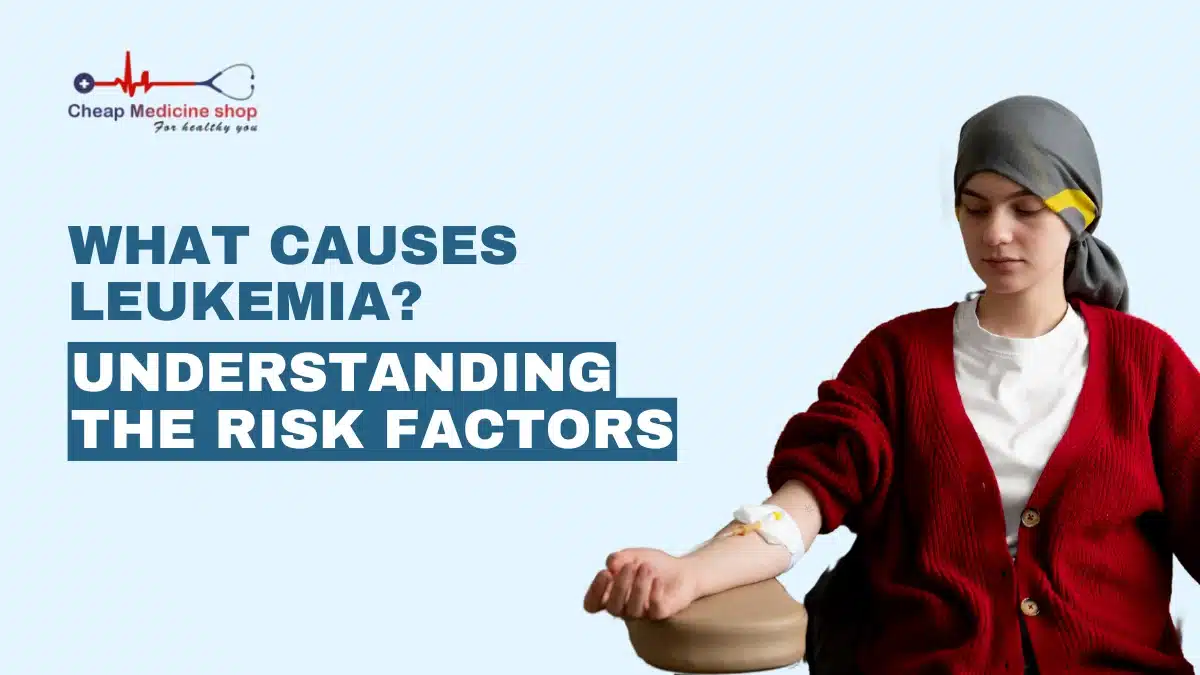Each year, Leukemia affects over 60,000 people, disrupting lives and prompting urgent questions about its origins.
This type of Blood Cancer initiates in the bone marrow, where white blood cells grow abnormally and in excess. These defective cells outnumber and suppress healthy blood cells, weakening or diminishing the immune system and making the body more prone to infections.
But what causes Leukemia in the first place? The answer lies in a complex blend of genetic predisposition, environmental exposures, and lifestyle factors. While some risks are beyond our control, others can be reduced with awareness and action.
In this article, we look into the known Leukemia causes and how you can lower your risks, so read on.
Genetic mutations and inherited conditions
Specific gene mutations can increase your risk of developing Leukemia. These gene changes that raise the risk of Leukemia are passed down from parents, while others can happen by chance at any point in life. Specific inherited conditions like Down syndrome, Fanconi Anemia, and Bloom syndrome significantly increase Leukemia risk.
DNA changes in specific genes can activate oncogenes (Cancer-promoting genes) or deactivate tumor suppressor genes, leading to uncontrolled cell growth. While these genetic factors are often beyond our control, understanding your family history can help identify if you’re at higher risk.
Save up to 90% on your medicine bills

Abraxane 100 Mg Injection

Alphalan 5 Mg Tablets

Adriamycin 50 Mg Injection

Abirapro 250 Mg Tablet
Radiation exposure
Being exposed to high doses of radiation is a recognized factor that significantly raises the likelihood of developing Leukemia.
Historical evidence comes from survivors of the atomic bomb explosions in Japan, who were found to have a significantly increased risk, particularly Acute Myeloid Leukemia (AML. Even medical radiation treatments like those used for other Cancers can increase Leukemia risk years later.
The risk depends on the radiation dose, exposure age, and duration. While diagnostic X-rays carry minimal risk, repeated high-dose exposures can damage DNA in bone marrow cells, potentially leading to Leukemia. People who received radiation therapy for previous Cancers have a slightly elevated risk of developing Leukemia later in life.
Chemical exposure
Long-term exposure to certain chemicals, particularly Benzene, has been associated with an increased risk for the development of one or more types of Leukemia. Benzene is found in gasoline, cigarette smoke, and some industrial settings. Workers in Benzene industries, such as oil refineries and chemical manufacturing, show higher rates of Leukemia.
Prolonged Benzene exposure increases the risk of Acute Myeloid Leukemia by up to 40%. Other Leukemia-related chemicals include Formaldehyde, certain pesticides, and industrial solvents. People in rubber manufacturing, oil refining, and chemical production industries face higher Leukemia risks and should follow safety protocols to minimize exposure.
Previous Cancer treatments
Ironically, the very treatments that cure one Cancer can sometimes cause another like Myelodysplastic Syndrome (MDS) and Acute Myelogenous Leukemia (AML). Certain chemotherapy medications, particularly alkylating agents and topoisomerase II inhibitors, can damage bone marrow DNA. This damage sometimes leads to treatment-related Leukemia, typically developing 5-10 years after the original Cancer treatment.
The risk varies based on the specific medications used, dosage, and whether radiation therapy was also administered. For example, patients treated with etoposide have about a 2-3% risk of developing treatment-related AML. While this risk is relatively small compared to the benefits of Cancer treatment, it’s an important consideration for long-term Cancer survivors.
Smoking
Tobacco smoke contains Benzene and other carcinogens that enter the bloodstream and can damage bone marrow cells. Smokers have a higher risk of developing Leukemia compared to non-smokers.
The risk elevates with both the duration and intensity of smoking. Even secondhand smoke exposure may increase Leukemia risk, particularly in children.
Certain viral infections
Specific viruses have been linked to certain types of Leukemia. Human T-cell Leukemia virus type 1 (HTLV-1) directly causes adult T-cell Leukemia/lymphoma, though this is rare in North America and Europe. The virus integrates into DNA and can transform normal cells into leukemic cells.
There’s also evidence suggesting that Epstein-Barr virus (EBV) may play a role in some Leukemia cases, particularly in individuals with weakened immune systems. While most people infected with these viruses never develop Leukemia, they represent a significant risk factor in specific populations.
Age and gender factors
Age and gender significantly influence Leukemia risk and type. Acute Lymphoblastic Leukemia (ALL) peaks in children aged 2-5, while Chronic Leukemias and AML are more common in older adults. After age 65, the risk of developing Leukemia increases substantially.
Gender also plays a role—men have a roughly 30% higher overall risk of developing Leukemia than women. This difference is most pronounced for Chronic Lymphocytic Leukemia (CLL) and Chronic Myeloid Leukemia (CML). These demographic factors can’t be changed, but they help doctors identify who might benefit from closer monitoring.
Weakened immune system
People with compromised immune systems face higher Leukemia risks. This includes those with HIV/AIDS, organ transplant recipients taking immunosuppressive medications, and people with certain autoimmune disorders.
If the immune system doesn’t work properly, abnormal cells might not be removed, allowing them to grow into Leukemia. The connection works both ways—some autoimmune conditions increase Leukemia risk, and conversely, certain Leukemias can cause immune system abnormalities. Regular monitoring is essential for those with known immune system weaknesses.
Pre-existing blood disorders
Certain blood disorders can transform into Leukemia over time. Myelodysplastic syndromes (MDS) and myeloproliferative neoplasms often precede Acute Myeloid Leukemia. About 30% of MDS cases eventually progress to AML, sometimes called “secondary AML.”
These pre-leukemic conditions involve abnormal blood cell production and function. Regular blood tests can help detect changes early for people with these conditions, making diagnosis and treatment more effective if Leukemia develops. The transition from these conditions to full-blown Leukemia happens over months to years, providing a window for monitoring and intervention.
Conclusion
Understanding what causes Leukemia reveals a complex interplay of genetics, environment, and lifestyle factors. While science has identified clear links between specific exposures, like radiation and Benzene, and increased Leukemia risk, many cases still occur without an obvious explanation.
The good news is that knowledge empowers prevention. You can reduce your risk by avoiding known risk factors like tobacco smoke and Benzene exposure. If you have a family history or genetic conditions associated with higher Leukemia risk, regular medical monitoring becomes even more critical.
For those with risk factors, awareness of early symptoms—unexplained fatigue, frequent infections, easy bruising, and unusual bleeding—can lead to earlier diagnosis and better outcomes. While we can’t prevent all Leukemias, understanding their causes brings us closer to more effective prevention and treatment strategies.

Frequently Asked Questions
Does Leukemia cause hair loss?
No, Leukemia itself doesn’t cause hair loss. However, chemotherapy treatments target rapidly dividing cells, including hair follicles, resulting in temporary hair loss. Most patients see regrowth beginning 3-6 months after completing treatment.
Can Leukemia cause blood clots?
Yes, Leukemia causes blood clots. Cancer cells release substances that activate the clotting system, while some treatments increase clotting risk. This complication affects 2-13% of Leukemia patients, particularly those with acute forms requiring immediate intervention.
Can Leukemia cause tumors?
No, Leukemia typically doesn’t form solid tumors. However, in rare cases, Leukemia cells may collect outside the bloodstream, forming chloromas or granulocytic sarcomas. These solid masses of leukemic cells can develop anywhere in the body.
Can tattoos cause Leukemia?
No, scientific evidence doesn’t support any link between tattoos and Leukemia development. Modern tattoo inks undergo safety regulations. While infections or allergic reactions occasionally occur with tattoos, these complications have no established connection to Leukemia risk.
Cheap Medicine Shop only refers to credible, authoritative sources for our content. If you’re curious about how we ensure the integrity of our content, we encourage you to read our Content Information Policy.












